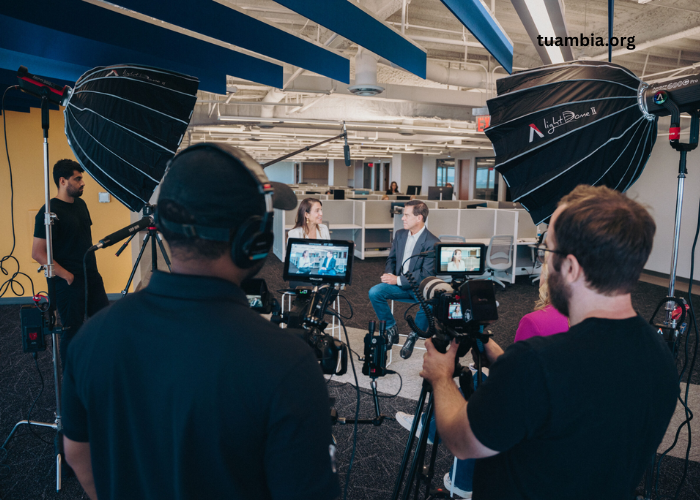It’s a question that hits every marketing team at some point, how much does video production cost? Whether you’re pitching internally, budgeting for a campaign, or comparing quotes, understanding what goes into the cost is key.
You’ve likely seen everything from $500 DIY videos to $50,000 brand films. Both can work. The difference lies in your strategy, not just spend. The right video connects with the right audience in the right format. This guide breaks down the true marketing video cost, what to expect at each budget level, and how to maximise ROI.
What Drives Video Production Pricing?
There’s no universal rate card. Instead, prices vary based on six core factors: scope, talent, crew size, location, post-production, and deliverables. If you’re shooting a series of social media clips with in-house talent and minimal editing, your cost will stay low. If you’re creating a polished brand film with multiple locations, a hired crew, and full animation, the investment goes up.
Phases of Video Production (and What They Cost)
Pre-production includes scripting, storyboarding, creative planning, and casting. Small projects might spend $300–$800 here, especially if you’re using internal staff and stock elements. Larger projects with concept development and professional writing can easily reach $1,000–$3,000+.
Production (filming) involves the actual shoot: hiring a videographer or a team, renting equipment, setting up lighting and sound, and coordinating logistics. A basic shoot with a solo videographer might cost around $800–$2,500 per day, while a full team with director, producer, and technical crew could run from $3,000 to over $10,000 per day.
Post-production includes editing, colour grading, sound mixing, music licensing, voiceover, subtitles, and more. A basic edit might start at $500 for a short clip. If you’re adding branded motion graphics, animated overlays, or multiple rounds of revisions, this can rise to $3,000 or more. Heavily animated or effects-driven projects may even hit $15,000+.
Common Types of Marketing Videos and Their Costs
Explainer videos, especially animated ones, range from $900 for basic template-based formats to over $10,000 for fully custom 3D animation with scripting and branding.
Customer testimonials can start at $600 if you’re filming one customer at one location with minimal editing. But if you’re creating a polished piece involving B-roll footage, multiple locations, and post-production storytelling, the budget may exceed $5,000.
Product demo videos vary significantly. A simple screen-recorded demo with voiceover might only cost $350–$700. A more visually dynamic demo with camera work, close-ups, and sound design could cost between $1,200 and $4,500.
Brand films are the most varied. A startup might spend $1,000–$2,500 on a basic in-office shoot, while mid-sized brands often invest $3,500–$7,500 for a more cinematic narrative. Premium brand videos with scripts, actors, sets, and multiple deliverables can exceed $30,000.
Social media videos can be cost-effective if you’re using UGC or in-house clips—expect $300–$900 per video. Professionally shot and edited campaigns typically range from $1,500 to $5,000, depending on deliverables and platform targets. High-end ad campaigns with creative direction and testing variations can stretch toward $15,000 or more.
What You Get at Different Budget Levels
If your video budget is under $1,000, you’re likely working with solo freelancers, mobile-based content, or repurposed material. That might include a short internal message, a quick testimonial, or a stripped-back social post.
Budgets between $1,000 and $3,000 give you access to professional equipment, some graphics, and light creative direction. This is ideal for startups, SaaS brands, or any team building landing page and YouTube content.
Spending between $3,000 and $10,000 opens the door to high-quality brand videos, multi-camera setups, scripted storytelling, and deeper post-production polish. This is the sweet spot for B2B lead-gen videos, explainer animations, and sales enablement content.
Budgets of $10,000 or more often mean hiring a full production team, handling multiple locations or versions, and creating hero content that lasts a year or longer. This range is typically used for brand films, PR assets, and integrated campaign pieces.
Hidden Costs Marketers Often Miss
It’s easy to forget the extras. Licensing music, stock footage, or fonts may add $100 to $1,000 to a project. Professional voiceover artists usually charge between $200 and $600 per session. Subtitles and captions, now essential for accessibility and social platforms, cost $3–$10 per minute. Then there’s travel and location costs—shooting at a rented space or flying out a crew can add thousands depending on distance and duration. Finally, be cautious about usage rights; some agencies include limited use only, with additional charges for paid ads, television, or multi-year use.
DIY vs. Hiring a Production Company
Doing video in-house offers more control and lower per-video costs in the long run, especially if you’re producing at scale. But you’ll need gear, trained staff, and time to manage production. A freelance editor or videographer may be enough for many internal or low-risk projects.
Hiring a production company saves time and delivers polished results fast. Agencies often include scripting, shooting, editing, and branding in their packages. For large campaigns or critical brand assets, this is usually the better option. In many cases, a hybrid approach works best: in-house for social and instructional content, outsourced for campaign videos and storytelling pieces.
Maximising ROI on Video Content
To get the most out of your video spend, plan to repurpose. A single brand film shoot could yield a full-length video, teaser trailers, customer interviews, vertical cuts for Reels, ad variations, and even GIFs. Don’t treat video as one-and-done build a library over time that supports multiple departments: sales, onboarding, HR, support, and retention.
Think in series, not singles. Instead of commissioning one testimonial, plan a 3-part case study series. Instead of a single feature demo, produce a feature spotlight playlist. Structuring projects this way helps stretch your budget and increase engagement.
Also, understand your goal before you invest. If your KPI is conversion, optimise for clarity and CTA not cinematic quality. If your KPI is awareness, focus on storytelling and shareability. Spending should always be aligned with the video’s purpose, not production quality for its own sake.
When It’s Worth Spending Big
You should invest more in video when launching a new product or rebrand, creating cornerstone content for your homepage, or developing a multi-platform campaign. Big spends also make sense if you’re entering new markets, looking for investor visibility, or targeting earned media. If the asset will be seen by thousands or influence millions in revenue spend accordingly.
When Lean Video Makes More Sense
Go lean for seasonal promotions, micro-campaigns, FAQ or support videos, email sequences, or social-first content. For these formats, speed and volume matter more than polish. User-generated content, in-house recordings, and mobile editing tools can deliver strong performance for a fraction of the cost especially on TikTok, Instagram, and short-form platforms.
Final Thoughts: Spend With Purpose, Not Just Production Value
So, how much does video production cost? It depends entirely on what you need, how you’ll use it, and how long you expect it to serve your business. There’s no universal rate, but there is always a right spend for the right outcome.
Focus on value, not vanity. A $1,500 testimonial that wins deals is more valuable than a $15,000 brand video nobody watches.
Strategic planning and smart execution are how marketers win with video not just by throwing money at production. Know your audience, know your message, and work backwards from your goal.






